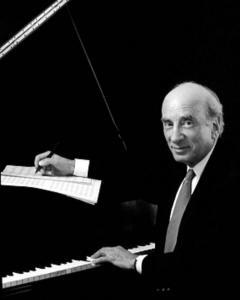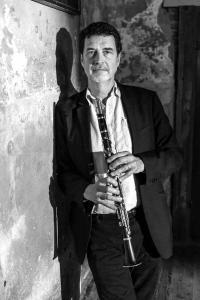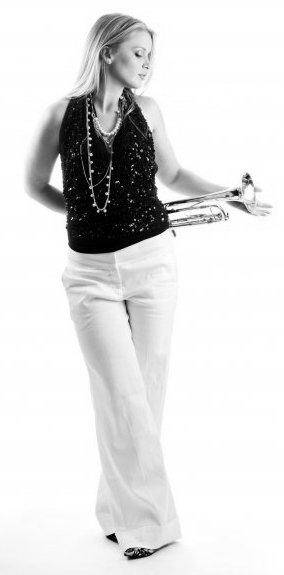Trumpeter Stan Mark was one of the first musicians that I interviewed for my on-going series of profiles. That was back in 1994 and took place at the Gold Coast Hotel & Casino in Las Vegas when he was a member of Jim Fitzgerald’s Sorta Dixie Jazz Band. Stan was a top-notch horn player and a big jazz education advocate. Never one to shirk from stating his opinion, he was considered a tad controversial and outspoken in the eyes of some people. But that was Stanley, and he had a colorful career and was always the source of great copy for those of us in the Fourth Estate.
Originally from the Keystone State of Pennsylvania, Stan aspired to play in the United States Navy Band, which he did for eight years. One of his duties was playing taps at Arlington National Cemetery burials, including President John F. Kennedy’s service. From there, he went on to be the lead trumpeter in Maynard Ferguson’s band, spent 10 years with a circus band at Disney World and touring with Ray Charles, and later ran a music studio, used record store and a limo company.
Longtime readers will probably best remember Stan from his leadership of the River City Stomperz during his time in Sacramento. Now after 46 years as a professional musician, he is fully retired, living in Reno, Nevada, and playing golf along with the usual activities that consume the daily regimen of a 71-year-old. The last time he performed was in 2009. “I never thought it would end,” he laments, but while acknowledging that the music has changed over the years, he believes it still has a future, quoting the late composer Jule Styne who said, “Good tunes can be played in any style and in any tempo.”
♫ ♫ ♫ ♫

A highlight of the 45th annual Bix Beiderbecke Memorial Jazz Festival (held in Bettendorf, Iowa for the first time because the usual venues in Davenport were otherwise committed) was a free afternoon concert at which Randy Sandke played Bix’s 1927 cornet, and Dick Hyman played the Beiderbecke family piano.
The veteran pianist turns 90 this coming March, but has no plans to retire. “I like to play; I like to play for people; and I like to compose,” he said, noting his latest piece—a clarinet concerto—premiered this past 4th of July. “I was first mesmerized by Bix at the age of 12 after listening to a record my brother brought home. The music isn’t as easy as it sounds. I continue to find new things in what I hear, and those things delight me.”
Read: Randy Sandke: A Study in Versatility & Dick Hyman’s Ongoing Musical Odyssey
♫ ♫ ♫ ♫
Chuck Redd had an unsettling couple of days in late July when he thought he had lost his bag of cymbals following a concert at the W.C. Handy Music Festival in Florence, Alabama. He inadvertently left the bag of five cymbals in a parking lot next to the Zodiak Listening Room where he had performed with an all-star group. The next night he borrowed cymbals from Mark Lanter, a fellow drummer from Birmingham, AL.
The following day, the bag of cymbals turned up in a church next door to the theater where they had been turned in by a Good Samaritan. A greatly-relieved Chuck’s reaction was, “I have faith in this cool town.” The response from a friend was, “I suppose you’re tired of people calling you ‘cymbal-minded.’”
The Handy Music Festival is named for William Christopher Handy, known as the “Father of the Blues,” who was born in a log cabin in Florence in 1873. It started 35 years ago with a few events during a weekend and has grown to feature approximately 300 mostly musical events in clubs, restaurants, churches recreation centers and parks over 10 days throughout the northwest region of Alabama known as The Shoals.
Read: Chuck Redd: A Drummer’s Odyssey
♫ ♫ ♫ ♫
Mary Grace and Jerry Lanese set the record straight that the national premiere of Vince Giordano’s documentary, There’s a Future in the Past actually took place in Kansas City in April, not in July, which was the New York premiere. According to the Laneses, the choice of K.C. was fitting because the Original Coon-Sanders Nighthawks Orchestra was formed, played and broadcast for many years from that mid-America city. When Giordano formed his orchestra in 1976, he took the Nighthawks name.
Related: Nighthawks on the big screen: Vince Giordano documentary to be screened on both coasts
♫ ♫ ♫ ♫

Charles Suhor had another pair of sharp eyes in writing that my reference to Tommy Sancton leading the Black Eagle Jazz Band “in the early 1950s” was off by some 20 years. (I should have checked my book, JAZZ BEAT: Notes on Classic Jazz, to determine the correct chronology.) Charles added a related story about Sancton that I’ll pass along. Thanks, Charles!
“In 1966; I was Tommy’s 11th grade English teacher in New Orleans Public Schools. He had been playing clarinet for a short time, tutored by Punch Miller at Preservation Hall. Tom wrote about that in an open-ended essay assignment that later won recognition in the annual awards of the National Council of Teachers of English (my future employer). At the time, I was writing for Down Beat, so I sent the piece to editor Don DeMicheal. It was published in the February 1976 issue. Tommy has often credited me with influencing his writing. But_his father, Tom, Sr., was noted as a novelist, cited by TIME as “the new Thomas Wolfe,” and young Tommy was a gifted writer when I met him.”
“While at Harvard around 1971, Tommy formed the Black Eagle Jazz Band, in emulation of early jazz styles. He, of course, kept playing during his career as Paris Bureau Chief for TIME magazine, and he wrote the cover story on Wynton Marsalis for an October 1990 issue. His jazz style evolved from a George Lewis sound-alike to an eclectic swing approach. He has made several recordings and remained active as both a musician and writer in retirement on returning to New Orleans. I told this story in my book Jazz in New Orleans: The Postwar Years through 1977. Tommy wrote tenderly of his relationship with his father in his book, Songs for my Fathers: A New Orleans Story in Black and White.”
Charles Suhor also wrote us an important remembrance of his brother: Don Suhor: An Important New Orleans Clarinetist
♫ ♫ ♫ ♫

My monthly Bria Report: Trumpeter-vocalist-songwriter Bria Skonberg’s latest recording—Bria— will be released by Sony Records on Sept. 21. She’s excited to be on the Okeh label that recorded Louis Armstrong’s Hot Fives and Sevens 90 years ago. Called “a unique fusion of modern day pop sensibility combined with sizzling musicianship,” Bria (or her publicist) is quoted as saying she “aimed for a sense of allure on the new album, music that is both curious and exotic. It’s playing with tension and storytelling, and tying together the best aspects of the music I’ve been exploring in my quest to fuse my love of classic jazz with worldly rhythm, percussion and contemporary songwriting.” The album features nine standards plus five original songs.
Read our review, Bria Skonberg: Three Albums Compared, and Lew’s profile, Bria Skonberg: A New Force in Jazz
♫ ♫ ♫ ♫
In the August issue of the South Bay New Orleans Jazz Club Blue Note newsletter, Larry Cosgrove told about buying a 33 RPM record back in the 1950s—Knuckles O’Toole Plays Honky Tonk Piano. Turns out that Knuckles O’Toole was actually the highly-respected Dick Hyman, a classically-trained pianist who won an on-air competition that awarded him 12 free lessons with Teddy Wilson.
Larry went on to mention other honky tonk pianists who enjoyed some popularity back then: Big Tiny Little, Jo Anne Castle (both from the Welk show), Crazy Otto, Joe “Fingers” Carr (a nom de disque of Capitol A&R man Lou Busch) and Fred “Mickey” Finn. To which, I’d certainly add the name of Max Morath.
Must ask our ragtime authority Brian Holland to explain the difference between honky tonk, boogie woogie and stride piano for the benefit of us non-musicians.
We did, read: Honky Tonk, Boogie Woogie, and Stride. What’s the Difference?
♫ ♫ ♫ ♫
The mid-summer tour of the 2016 Django Reinhardt NY Festival from France included eight cross-country concerts, an appearance at the Newport Jazz Festival in Rhode Island, and a six-night stand at Birdland in the Big Apple, at which a number of top American jazz musicians sat in.
♫ ♫ ♫ ♫
The Sacramento Traditional Jazz Society is presenting a mini-jazz festival on four stages from 5 to 10 p.m. on Sunday, Sept. 11 at Elks Lodge #6 (6446 Riverside Blvd).
♫ ♫ ♫ ♫
Out of respect for the horrific killing of 84 people in Nice, France on July 14 (Bastille Day), the 2016 Nice Jazz Festival, which was scheduled to open a five-day run starting on July 16, was canceled.
♫ ♫ ♫ ♫
With all the festivals held in that city, New Orleans has been referred to as “The City of Celebration.”
Where we can link directly to an artist, publisher, or record label when mentioning an item we do so. For items where this is not possible, we link to Amazon. When you follow those links and make any purchase from their site we receive a percentage. “As an Amazon Associate we earn from qualifying purchases.”
Lew Shaw started writing about music as the publicist for the famous Berkshire Music Barn in the 1960s. He joined the West Coast Rag in 1989 and has been a guiding light to this paper through the two name changes since then as we grew to become The Syncopated Times. 47 of his profiles of today's top musicians are collected in Jazz Beat: Notes on Classic Jazz.Volume two, Jazz Beat Encore: More Notes on Classic Jazz contains 43 more! Lew taps his extensive network of connections and friends throughout the traditional jazz world to bring us his Jazz Jottings column every month.






















